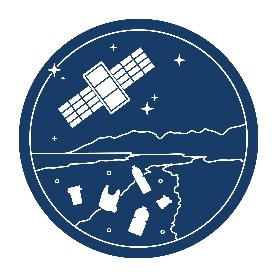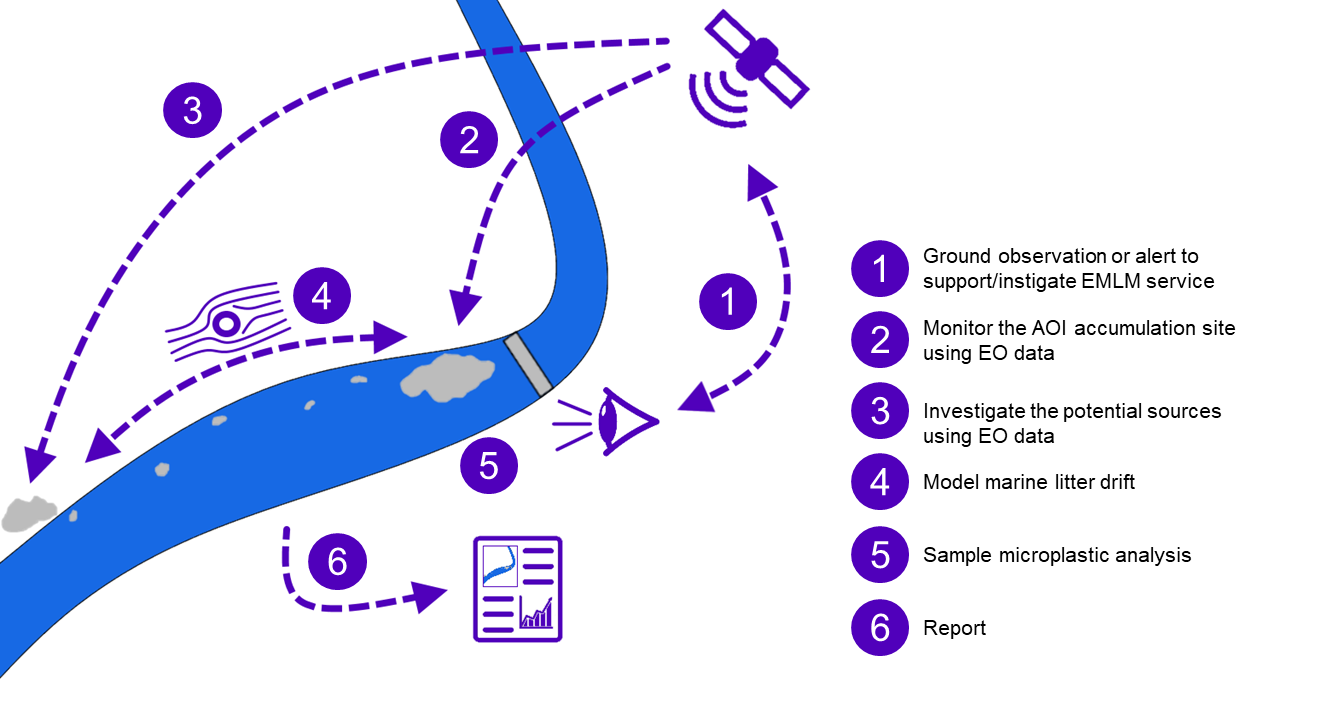
Objectives of the service
In recent years marine plastic pollution has increased in global profile. It has been widely reported that plastic pollution is one of the largest anthropogenic threats to our marine environment of this century . Policies relating to the management of plastic waste are an increasingly high priority within environmental sustainability agendas.
The study investigated the feasibility of an innovative Environmental Marine Litter Monitoring (EMLM) Earth Observation (EO) data-driven mapping and monitoring solution for detecting mega and macro floating marine plastic litter. Improving knowledge of the sources, pathways, and trends of plastic pollution in rivers and estuaries is key to the successful implementation of regional and local waste management systems.
The focus of EMLM was to determine the feasibility of Earth observation satellites to detect and monitor large accumulations of floating plastic litter and to model the predicted movement of the identified debris as it travels from the source, along rivers and estuaries, and into the Oceans. This is supported with in-situ detection and quantification of microplastics using portable systems and laboratory analysis.
The aim of EMLM is to implement a monitoring service that can examine environmental changes due to excess plastic litter within river and estuary environments.
Image – Planet and PlanetScope quasi-daily full Earth land coverage, Bosnia ©Plane
Users and their needs
Globally there are many important user groups that would benefit from the identification and tracking of large accumulations of marine plastic litter. For this study we have focussed on two communities: International conservation organisations and marine waste collection companies and have had discussions with organisations including: WWF, The Ocean Cleanup, The SeaCleaners, Plastic Europe, Plastic Odyssey and others involved in plastic clean up and collection.
International conservation organisations, such as WWF, support the establishment of an international legally binding agreement through the UNEA to reduce the input of plastic into the oceans. For them, it is important to develop a scientifically robust system, that can be reliably used to establish a global marine plastic monitoring system to understand the input of marine litter into the sea at an international level. In addition, clear visuals and success stories provide vital educational tools for communities and support the uptake of local clean-up programmes.
Marine plastic waste collection companies are often technology focussed and are interested in accurately identifying locations where plastic has accumulated within river and estuary environments. With this knowledge they can quickly mobilise their highly advanced collection systems/boats, gather the floating plastic debris and deliver it to local plastic recycling businesses for reintroduction into the plastic circular economy.
The users involved in the activity selected several target locations across Europe and South East Asia within river and estuary environments that have significant environmental challenges due to excess marine plastic waste. Four locations identified by end users, and located in Eastern Europe, SE Asia and the Caribbean, were examined as pilot study sites.
Service/ system concept
EMLM offers a new service that enhances awareness of plastic discharge along rivers and estuaries before reaching the open oceans. Currently, marine debris is barely monitored. By identifying the presence of marine litters, its geographical origin, and modelling its future behaviour, EMLM will enhance plastic pollution understanding and help tailor collection campaigns while influencing policy makers, in addition to enhancing public awareness.
The EMLM service provides valuable information on the distribution of marine litters by combining optical, radar and multispectral data, mapping expertise, drift modelling, and in-situ monitoring where required (e.g., microplastic sampling). EMLM provides regular monitoring at sites of known waste source and accumulation (e.g. landfill sites, illegal dumps or river obstruction, dam) or at a specific end user area of interest (AOI) within a river or estuary. Following the initial identification of a hotspot location, daily, weekly, or monthly EO data is acquired and processed (1, 2 and 3). The satellite derived data, combined with met-ocean and any in-situ information, is input into state-of-the-art modelling technologies to identify plastic drift direction (4). As required by end users, the microplastic contamination and typology on the sediments (5) can be obtained using in-situ sample collection and laboratory analysis.

The system reports information on marine litter distribution, size, and spatial-temporal information via email alert and reports, with the potential of access via an online portal. A pre-operational demonstration project will be required to further develop the system.
Space Added Value
EMLM uses a combined approach to satellite imagery investigation, using low to high resolution radar and optical, future high temporal and hyperspectral systems, and metocean satellites. Within the feasibility study EMLM identified the technical capabilities and limitations each of these systems for plastic detection.
EMLM combines EO data with state-of-the-art modelling to track the drift of plastic debris along rivers and estuaries based on predictive modelling of floating debris and metocean data.
Moreover, at user request, in-situ sample collection and lab analysis can be undertaken to calculate a contamination index within the marine sediment.
Current Status
The EMLM feasibility study commenced in March 2021 and the Final Meeting took place in March 2022.
Prime Contractor(s)
Subcontractor(s)





